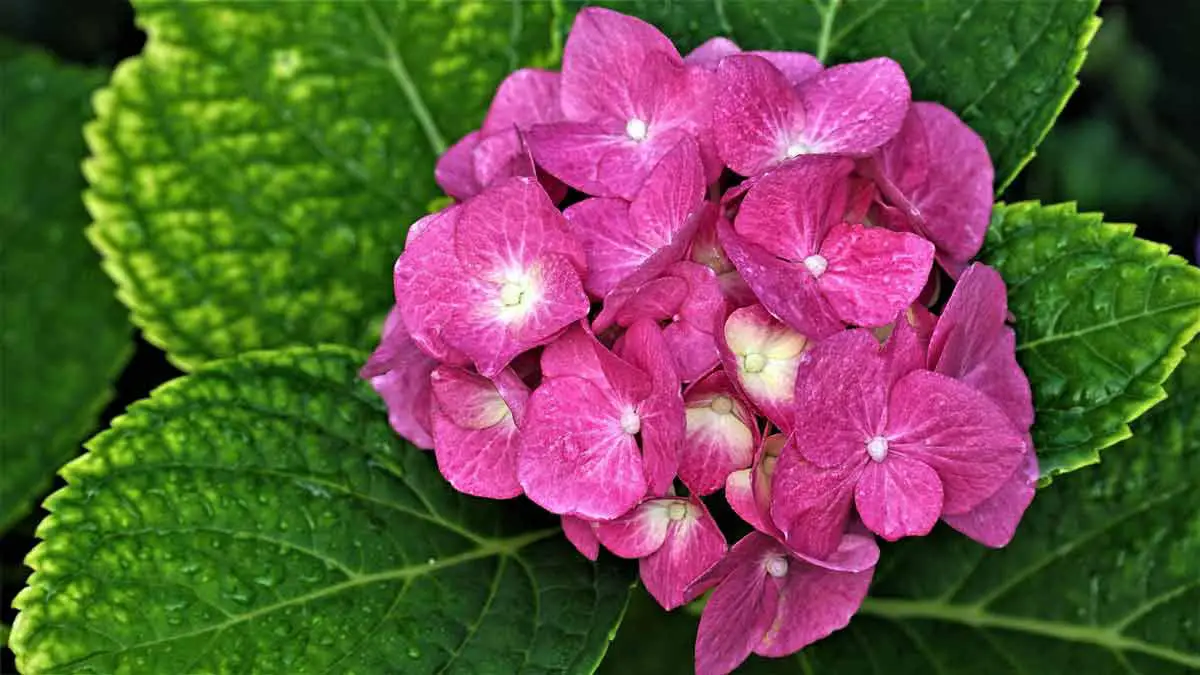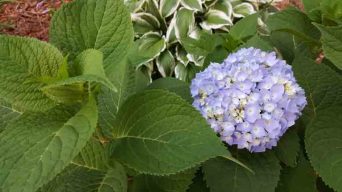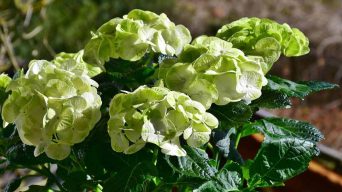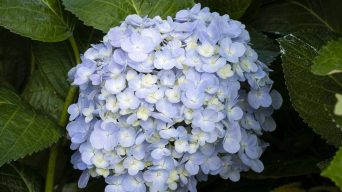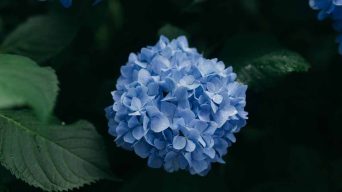Hydrangea plants are popular for their large, showy flower clusters that bloom in various colors.
While most hydrangeas have green leaves, some varieties feature foliage that turns red, burgundy, or purple in the fall.
If your hydrangea’s leaves turn white, it could be due to several reasons, including disease, pests, or environmental stressors.
Here are seven possible explanations for why your hydrangea leaves might turn white, along with some tips on fixing the problem.
Why Are Hydrangea Leaves Turning White
Knowing why your hydrangea leaves are turning white can help you take the necessary steps to fix the problem.
The most common reasons for white leaves on hydrangeas are:
1. Powdery Mildew
One of the most common reasons hydrangea leaves turn white is powdery mildew.
Powdery mildew is a type of fungal disease that affects a wide range of plants, including hydrangeas.
This fungal disease is characterized by a white, powdery growth on the leaves and stems of affected plants.
Powdery mildew usually develops in humid or wet conditions and can spread quickly to other parts of the plant.
How To Tell If Your Hydrangea Has Powdery Mildew
If you think your hydrangea plant has powdery mildew, look for the following symptoms:
- White, powdery growth on the leaves
- Wilting or yellowing leaves
- Leaves that are curled or distorted
- Stunted plant growth
How To Treat Powdery Mildew On Hydrangeas
It’s essential to treat powdery mildew as soon as possible to prevent the disease from spreading and causing further damage to your plant.
You need to isolate any affected plants to prevent the disease from spreading.
Remove any infected leaves or stems and dispose of them properly.
You can also treat powdery mildew with a natural fungicide, such as neem oil.
To use neem oil, mix it with water according to the manufacturer’s instructions.
Then, apply the mixture to the affected areas of your plant.
Be sure to cover all of the infected leaves and stems.
You’ll need to reapply the neem oil every 7-10 days until the fungal infection is gone.
2. Sunburn
Hydrangeas are typically planted in shady areas to protect them from the hot sun.
However, the leaves can become sunburned if your plant is placed in an area that gets too much sun.
This will cause the leaves to turn white or pale yellow.
The edges of the leaves may also be brown or dead.
How To Tell If Your Hydrangea Is Sunburned
If you think your hydrangea is sunburned, look for the following symptoms:
- White or pale yellow leaves
- Brown or dead leaf edges
- Leaves that are wilting or drooping
- Brown spots on the leaves
How To Treat Sunburn On Hydrangeas
If your hydrangea plant is sunburned, you’ll need to move it to a shadier location.
Hydrangeas need at least 4 hours of direct sunlight each day, so be sure to place them in an area with partial shade.
An east- or west-facing window is a good option. This will help prevent the leaves from getting too much sun and allow them to recover.
You can also try using a sheer curtain or blind to filter the light.
3. Low Light
Hydrangeas need at least 4 hours of direct sunlight each day to thrive.
The leaves turn pale or white if your plant is not getting enough light.
Plants need light to produce chlorophyll, which gives leaves their green color.
The leaves will lose their color without enough light and eventually turn white.
How To Tell If Your Hydrangea Is Not Getting Enough Light
If you think your hydrangea is not getting enough sunlight, look for the following symptoms:
- Pale or white leaves
- Leaves that are yellowing or wilting
- Stunted plant growth
- Smaller than normal leaves
- Plant stretching towards the light
How To Treat A Hydrangea That Is Not Getting Enough Light
If your plant is not getting enough light, you’ll need to move it to a brighter location.
Hydrangea plants thrive in bright indirect sunlight.
An east- or west-facing window is a good option. This will give the plant the light it needs without being too harsh.
If you can’t move your plant to a brighter location, you can try using grow lights.
Grow lights mimic the sun’s rays and can provide your plant with the light it needs to grow.
4. Pest Infestation
Hydrangea leaves may change color, appearing yellow or white, when plagued by pests. These pests extract nutrients from the leaves, resulting in a loss of their natural coloration.
Several common pests can affect hydrangea plants, including aphids, whiteflies, and spider mites.
Aphids are small, green or black insects that feed on plant sap. Whiteflies resemble tiny white moths in appearance. Spider mites, on the other hand, are minuscule red or brown bugs that spin delicate webs on the leaves of the plants.
How To Tell If Your Hydrangea Is Infested With Pests
To identify pest infestation on your hydrangea, watch for these key symptoms:
- White or yellow leaves
- Wilting or drooping leaves
- Stunted plant growth
- Leaves shrouded in webs
- Presence of small bugs on the leaves
How To Treat A Hydrangea That Is Infested With Pests
If your plant is infested with pests, you can remove them by spraying it with water.
You can also try using an insecticidal soap or neem oil.
Mix 1 tablespoon of dish soap with 1 gallon of water to make an insecticidal soap.
Spray the mixture on the affected areas of your plant.
Be sure to cover all the bugs and get the leaves underside.
You can also try using neem oil.
Neem oil is a natural insecticide that comes from the neem tree.
Mix 1 tablespoon of neem oil with 1 gallon of water to use it.
Spray the mixture on your plant, cover all the bugs, and get the leaves underside.
5. Nutrient Deficiency
Hydrangeas need certain nutrients to grow.
The leaves can turn white or yellow if your plant is not getting enough of these nutrients.
The most common nutrient deficiency in hydrangeas is iron.
Hydrangeas need iron to produce chlorophyll, which gives leaves their green color.
Without enough iron, the leaves will lose color and eventually turn white.
Other nutrients that hydrangeas need include nitrogen, phosphorus, and potassium.
How To Tell If Your Hydrangea Has A Nutrient Deficiency
If you think your hydrangea has a nutrient deficiency, look for the following symptoms:
- White or yellow leaves
- Leaves that are wilting or drooping
- Stunted plant growth
- Smaller than normal leaves
- Leaves that are discolored or have spots
How To Treat A Hydrangea With A Nutrient Deficiency
If your plant has a nutrient deficiency, you can treat it by fertilizing it.
Choose a balanced fertilizer high in nitrogen, phosphorus, and potassium.
Be careful not to overfertilize your plant, which can cause the leaves to turn yellow.
You should fertilize your plant every two weeks during the growing season.
You can also try using compost or manure to fertilize your plant.
Compost is a great way to add nutrients to your plant.
Manure is also high in nutrients and can help to replenish the soil.
6. Water Quality
The quality of the water you use to water your plant can also affect the leaves.
The leaves can turn white or yellow if the water is too high in chlorine.
Chlorine is a chemical that is added to water to kill bacteria.
While it is effective at killing bacteria, it can also damage plants.
How To Tell If The Water Is Too High In Chlorine
If you think the water is too high in chlorine, look for the following symptoms:
- The leaves of the plant are turning white or yellow
- The tips of the leaves are brown or burned
- The plant is wilting
- The flowers are brown or discolored
How To Treat A Plant That Is Watered With Chlorinated Water
If you think your plant is being watered with chlorinated water, you can try watering it with distilled water or rainwater.
Distilled water is free of chlorine and other chemicals.
Rainwater is also free of chemicals and is a good option for watering your plants.
You can also let the tap water sit for 24 hours before watering your plant.
This will allow the chlorine to evaporate from the water.
7. Temperature Stress
Hydrangeas are sensitive to temperature changes.
The leaves can turn white if the temperature is too hot or too cold.
Hydrangea plants need to be in an area that is between 60°F and 80°F.
The leaves will turn white if the temperature gets too hot or too cold.
Extreme fluctuations in temperature can also cause the leaves to turn white.
How To Tell If The Temperature Is Too Hot Or Too Cold
If you think the temperature is too hot or too cold, look for the following symptoms:
- The leaves are wilting
- The flowers are drooping
- The leaves are turning yellow or brown
- The leaves are falling off
How To Treat A Plant That Is Exposed To Extreme Temperature Changes
If you think your plant is exposed to extreme temperature changes, you can try moving it to a different location.
Choose an area that is sheltered from the wind and has a consistent temperature.
Keep the plant out of direct sunlight and away from heaters or air conditioners.
You can also try using a fan to create a breeze or to cool the plant down.
Make sure you check the temperature of the room before moving your plant.
You don’t want to expose your plant to a sudden change in temperature.
How To Prevent Hydrangea Leaves From Turning White
You can do a few things to prevent your hydrangea leaves from turning white.
Here are a few tips:
- Place your hydrangea in an area with morning sun and afternoon shade.
- Avoid too much direct sunlight, which can cause the leaves to turn white.
- Make sure the soil is moist but not soggy.
- Water your plant deeply and regularly, making sure to not over or underwater it.
- Fertilize your plant monthly during the growing season.
- Prune dead or diseased branches as soon as you notice them.
- Mulch around the base of the plant to help retain moisture in the soil.
- Avoid using chemicals near your plant, as they can be harmful.
- Use organic methods to control pests and diseases.
Following these tips can help prevent your hydrangea leaves from turning white.
Final Thoughts
To keep your hydrangea leaves looking green and healthy, giving them the proper care is essential.
This includes making sure they get enough water and sun, as well as providing the proper nutrients.
If you notice your hydrangea leaves turning white, it could be due to several reasons.
The most common include powdery mildew, sunburn, and lack of light.
However, several other potential causes include pests, temperature stress, and nutrient deficiency.
You can preserve your hydrangeas looking beautiful by identifying the problem and taking action to fix it.
Try out different solutions until you find the one that works best for your plants.

